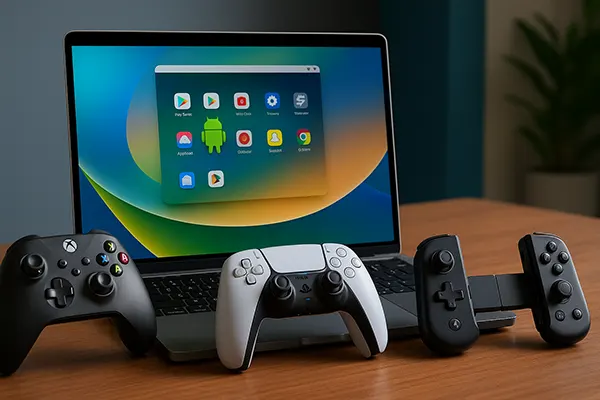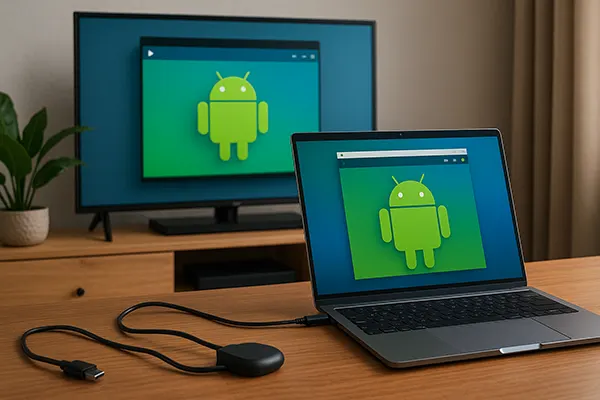Testing Android Emulators on Mac M3 with Gamepads: PS5, Xbox, Backbone Compatibility in 2025

In 2025, the gaming experience on Mac computers has reached new heights thanks to the Apple Silicon M3 chip and the growing popularity of Android emulators on macOS. However, one crucial component for a complete gaming setup remains the gamepad. This article explores the current state of gamepad support—specifically PS5 DualSense, Xbox Series X|S, and Backbone One—across popular Android emulators running on macOS Sonoma with M3 architecture.
Gamepad Integration on macOS Sonoma with M3
The M3 chip introduces enhanced performance and improved Bluetooth handling, which directly benefits game controller compatibility. macOS Sonoma now natively supports a wide range of Bluetooth and USB-C controllers, enabling seamless pairing with PS5 DualSense, Xbox Wireless, and third-party models like Backbone One (Lightning or USB-C).
Thanks to macOS’s expanded API support for gaming hardware, Android emulators such as BlueStacks, NoxPlayer, and AetherSX2 can better interpret and map controller inputs. This means reduced latency, fewer input dropouts, and more accurate analogue stick and trigger recognition—especially important in FPS and racing games.
Emulators also utilise Metal graphics API, allowing better resource allocation for input processing. This helps synchronise emulator performance with gamepad feedback, such as adaptive triggers or rumble motors, which are partially supported by DualSense in apps like AetherSX2.
Limitations and Compatibility Gaps
Despite these advancements, some limitations remain. For instance, not all emulators offer native support for advanced haptics or adaptive triggers, even if macOS can detect them. Features like LED lighting and mic passthrough (on DualSense) are usually ignored by emulator software layers.
The Backbone One controller, while excellent for iPhones, has limited native support for emulators on macOS unless used via remapping software like Joystick Mapper. It’s recognised as a generic HID device and may not offer full analogue stick sensitivity without configuration.
Xbox controllers maintain the most consistent compatibility across emulators, especially when connected via Bluetooth. However, users should be aware of firmware version mismatches, which might lead to dropped connections or unresponsive buttons during gameplay.
Performance of Popular Android Emulators with Controllers
Among the top Android emulators for macOS in 2025, BlueStacks 10 stands out for its robust controller mapping options and smooth operation on M3 chips. It detects DualSense and Xbox gamepads automatically and allows custom button layouts. NoxPlayer, while slightly behind in visual optimisation, has improved its controller plugin to support Xbox Series X controllers without third-party drivers.
AetherSX2, designed for PlayStation 2 emulation, provides near-native PS5 controller support and emulates pressure-sensitive buttons—useful for racing or stealth-action games. This emulator also benefits from the Metal API on macOS, resulting in low CPU overhead even during input-heavy sequences.
Other emerging emulators, such as LDPlayer for macOS beta, show promise but remain unstable with controller support. Gamepad functionality can drop during game transitions or fullscreen mode, and advanced haptics are not implemented.
Controller Setup Tips for Maximum Compatibility
Ensure macOS Sonoma is fully updated, as each system patch often brings improved controller handling. Also, update controller firmware via official tools on Windows or iPhone before connecting to Mac.
Use Bluetooth over wired connections for Xbox and PS5 controllers unless you encounter latency. USB-C tends to work better with DualSense, especially when using Steam or crossover software in parallel.
For remapping, tools like Enjoyable, Gamepad Mapper, or built-in emulator settings can bridge functionality gaps. These allow manual adjustments for games with limited default support.

Outlook for Controller Support on Emulators in 2025
With the M3 chip setting new standards for Mac gaming, developers of emulators are investing more effort into controller optimisation. Already in beta versions of emulators like BlueStacks X and AetherSX2 Nightly, full PS5 DualSense support is being tested—including touchpad gestures and speaker output.
Apple’s Game Controller framework, integrated into macOS Sonoma, opens the door for broader and more reliable gamepad functionality without third-party drivers. This encourages emulator developers to streamline controller compatibility in future updates.
By the end of 2025, we can expect controller parity with Windows systems across most popular emulators. Until then, Mac users benefit from partial but expanding support, with the Xbox controller still offering the best plug-and-play experience.
Is It Worth Using a Controller for Android Games?
Many Android games have evolved to support controller input, especially console ports like “Dead Cells,” “Castlevania: SotN,” and “Minecraft.” Using a physical gamepad enhances precision and reduces hand fatigue compared to keyboard-mouse remapping or touch controls.
In emulator environments, controller input also allows for console-style gameplay with split-second reactions—ideal for fighters or sports titles. Some apps even unlock hidden controller settings not accessible via touch UI.
For casual users, setting up a controller may be more effort than it’s worth. But for competitive or long-session players, the comfort and accuracy of a physical controller is a valuable addition to the Mac gaming setup.
